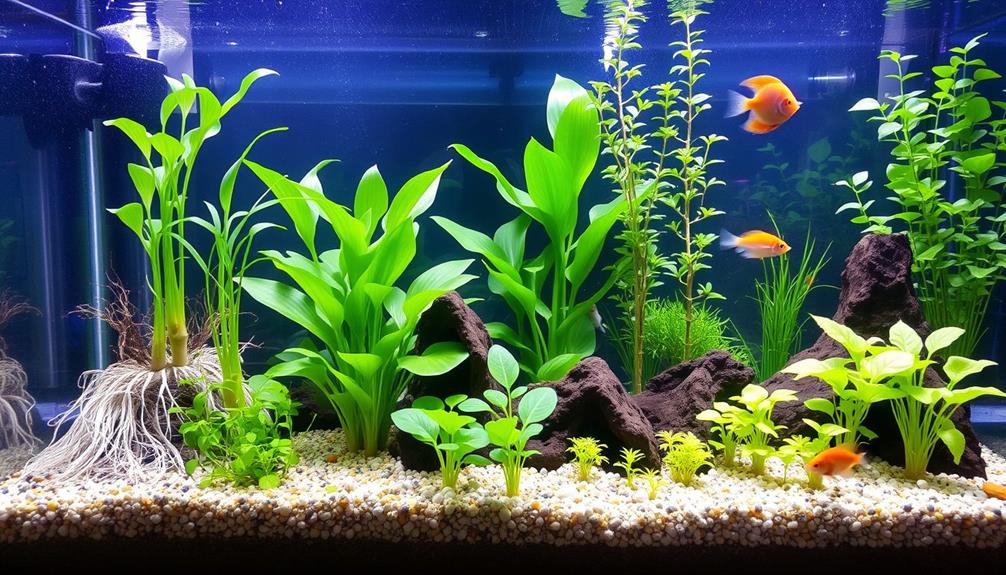If you want to propagate aquarium plants, start by understanding the various types. Stem plants like Rotala thrive with cuttings, while rhizomes like Java fern require careful attachment to hard surfaces. Regular trimming keeps plants healthy, so use tools like sharp scissors for clean cuts. Consider methods such as offshoot separation for rosette plants and fragmentation for mosses. Your water's quality is crucial, so check nutrient levels regularly. Choose hardy species for the best results, and soon you'll see your aquarium flourish. Discover more effective techniques to enhance your propagation success and overall aquarium health.
Key Takeaways
- Familiarize yourself with different types of aquarium plants, such as rhizome, stem, and moss plants, to choose suitable propagation methods.
- Use healthy cuttings taken below a node for stem plants, promoting robust growth when propagated properly.
- Engage in rhizome division for rhizome plants, ensuring careful removal to prevent damage during propagation.
- Implement a consistent trimming schedule to encourage healthy growth and prevent overgrowth in your aquarium.
- Monitor water parameters and maintain nutrient-rich substrates to support healthy plant growth and overall tank health.
Types of Aquarium Plants
When diving into the world of aquarium plants, it's essential to understand the different types available. Each type has unique characteristics that affect how you care for them and their propagation methods. Just as diversifying a retirement portfolio can enhance financial security, incorporating a variety of plant types in your aquarium can promote a balanced ecosystem.
Additionally, researching reputable dealers for aquarium supplies can guarantee you acquire healthy plants that thrive in your setup.
Rhizome plants, like Java fern, thrive when their rhizomes are attached to hardscape materials rather than buried. Stem plants, such as Rotala and Ludwigia, are easy to propagate through cuttings, and regular trimming encourages healthy growth.
You can also consider mosses like Java moss, which can regrow from small fragments attached to surfaces.
Bulb plants, including Aponogeton and Crinum, propagate through side shoots from bulbs; just be careful not to split or damage the bulbs during this process.
Finally, rosette plants, such as the popular Amazon Sword, can be propagated by dividing offshoots at the base, guaranteeing the crown remains intact in a nutrient-rich substrate.
Understanding these types of aquarium plants will help you create a thriving aquatic environment and effectively propagate them as your collection grows. Each plant type plays a unique role, contributing to the overall beauty and balance of your aquarium.
Trimming Techniques
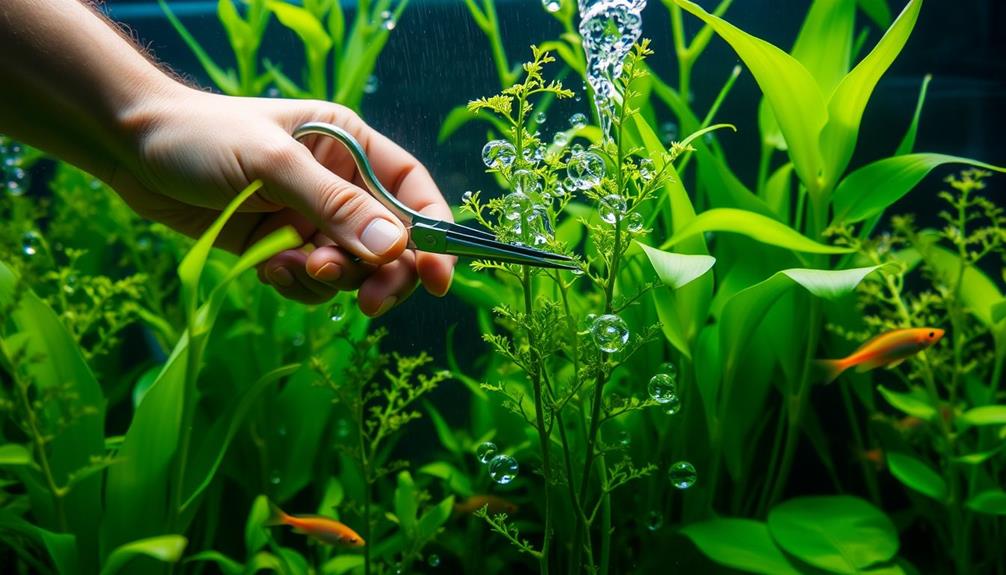
When it comes to trimming your aquarium plants, using the right tools and techniques is key to promoting healthy growth.
Regular maintenance, much like importance of HVAC maintenance, guarantees your plants thrive and prevents any issues from escalating.
You'll want to keep your scissors sharp for clean cuts and trim strategically to encourage new shoots.
Let's explore essential trimming practices and the tools that can help you maintain a thriving underwater garden.
Essential Trimming Practices
Effective trimming techniques are essential for maintaining a vibrant aquarium ecosystem. Regular trimming not only promotes ideal plant growth but also enhances the overall aesthetic of your aquatic plants.
To guarantee your plants thrive, follow these essential practices:
- Trim stems just above a node to encourage new growth and robust roots. This is similar to the way tough dog names can instill strength in dogs, guaranteeing they grow strong and healthy.
- Remove unhealthy leaves from rhizome plants like Anubias, and avoid burying the rhizome in substrate.
- When dealing with mosses, use a siphon to eliminate floating fragments and maintain water quality.
- Establish a consistent maintenance routine to prevent lower leaves from rotting due to poor light penetration.
Tools for Effective Trimming
To achieve precise and efficient trimming, investing in the right tools is essential. Using sharp scissors or aquascaping pinsettes, you're able to make clean cuts that promote healthy regrowth in your aquarium plants. Consider using UNS wave scissors for horizontal trimming to maintain the desired shape of carpeting plants and prevent overgrowth that blocks light penetration.
When you trim plants, always cut just above a node or healthy leaf. This encourages ideal new growth and prevents damage. Regular trimming not only enhances the aesthetics of your aquarium but also supports plant health by ensuring adequate light penetration and preventing lower leaves from rotting.
After trimming, employ a siphon to remove any floating debris, which helps maintain water quality and clarity. Below is a simple guide to the essential trimming tools:
| Tool Type | Purpose | Benefits |
|---|---|---|
| Sharp Scissors | Trim plants | Clean cuts for healthy growth |
| Aquascaping Pinsettes | Precision trimming | Targeted cuts for new growth |
| Siphon | Clean the tank after trimming | Maintains water quality |
Propagation Methods
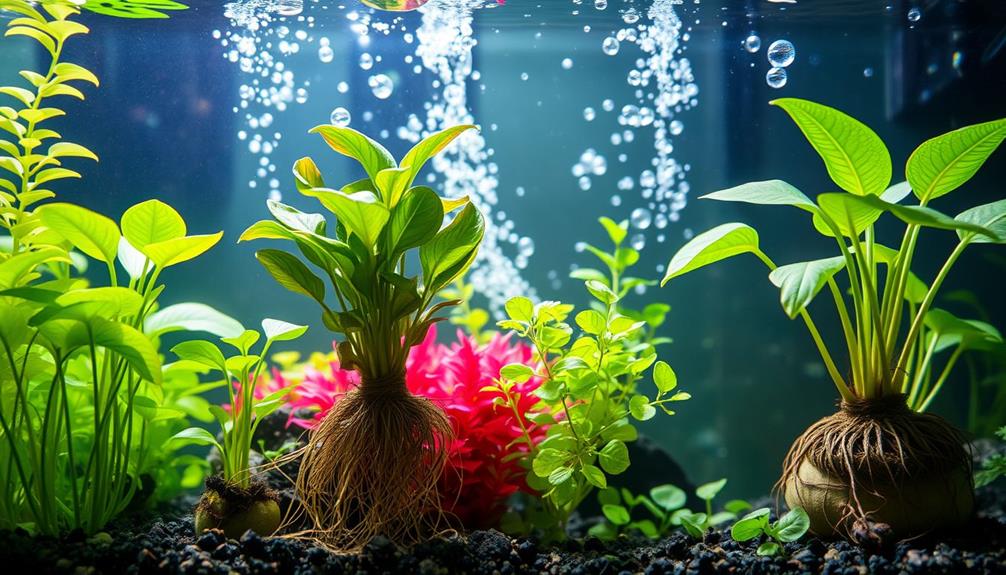
Propagation methods are essential for expanding your aquarium plant collection and ensuring healthy growth. By using various techniques, you can quickly create new plants that thrive in your tank. Incorporating unique indoor planters can enhance the aesthetics of your aquarium setup as well.
Here are some effective methods to contemplate:
- Cuttings: Take healthy stem cuttings just below a node. When you replant them in the substrate, roots grow quickly, promoting robust development.
- Rhizome Division: For rhizome plants like Anubias, carefully remove the rhizome from the substrate. Make sure each segment has a couple of leaves for successful reattachment to hardscape.
- Offshoot Separation: With rosette plants like Amazon Sword, separate offshoots from the parent plant at the base. These can be replanted to grow independently.
- Moss Fragmentation: Even small fragments of moss can propagate. Trim and attach these pieces to surfaces with black thread, allowing them to regrow and spread effectively.
If you're looking to propagate plants in your aquarium, using these methods will help you create a lush, vibrant environment. Each technique has its benefits, so choose the one that suits your plants best!
Maintenance Strategies
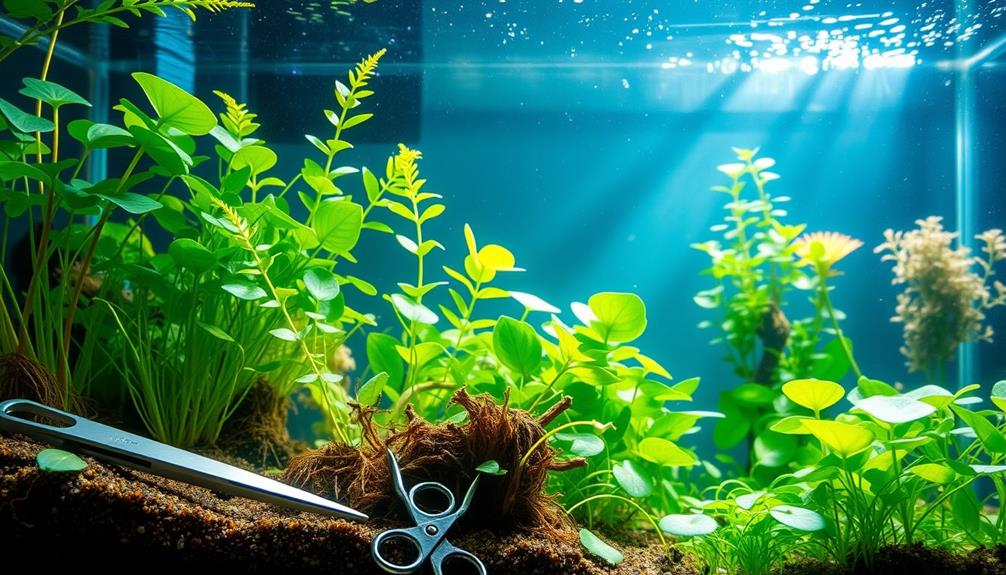
Maintaining ideal conditions in your aquarium is essential for ensuring that your propagated plants thrive. Start by regularly monitoring water parameters, such as pH and nutrient levels. This helps create a healthy environment for plant propagation.
Additionally, consider the impact of environmental factors on your aquarium plants, as some scents or substances may deter growth and health, similar to how cats react to certain odors understanding toxicity to cats.
Implementing a consistent trimming schedule is critical, too. It prevents overgrowth, promotes light penetration, and encourages new growth from your cuttings.
Using nutrient-rich substrates, like UNS Controsoil, supports root development and enhances the overall health of your propagated plants. After trimming or propagating, turn off the filter and use a siphon to remove any floating debris. This step is essential for maintaining water quality in your aquarium, allowing your plants to flourish.
Don't hesitate to engage with the aquarium community. Sharing experiences can lead to valuable insights and effective maintenance strategies tailored for plant propagation.
By combining these practices, you'll create an ideal environment for your aquatic plants, resulting in robust growth and vibrant displays in your aquarium.
Tools for Plant Care
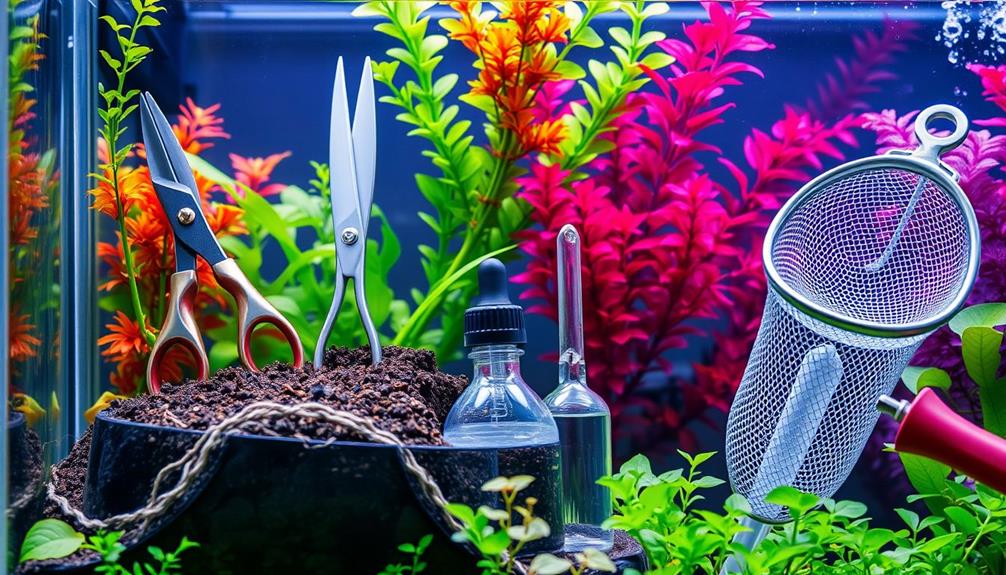
Having the right tools can make a significant difference in how well you care for your aquarium plants. With the proper equipment, you'll find it easier to trim, propagate, and maintain the beauty of your underwater garden.
Additionally, using the right techniques and maintenance practices guarantees a thriving aquatic environment, much like how cleaning your sprayer immediately is essential for maintaining peak performance.
Here are some must-have tools for effective plant care:
- Sharp Scissors: These are essential for clean cuts when you trim your plants, preventing damage and encouraging healthy regrowth.
- Aquascaping Pinsettes: Perfect for planting delicate stem and carpeting plants, they allow for precise placement in the substrate without disturbing neighboring plants.
- UNS Wave Scissors: Ideal for horizontal trimming of carpeting plants, these scissors promote even growth and prevent overgrowth that can block light.
- Siphons: Use siphons after your trimming sessions to clean up floating debris and maintain water quality in your aquarium.
Don't forget about black thread for attaching moss trimmings to surfaces, making it easier to propagate and guaranteeing stable growth on hardscapes.
With these tools in hand, you'll be well-equipped to nurture your plants and create a thriving aquatic environment.
Benefits of Aquarium Plants
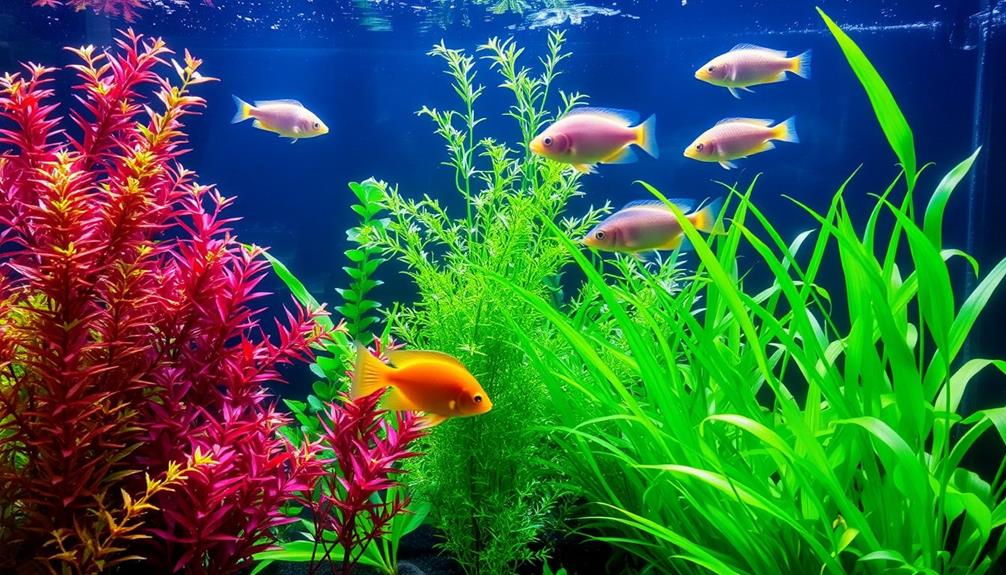
When you introduce aquarium plants into your tank, you're not just enhancing its beauty; you're also creating a healthier environment for your aquatic life. These plants play a crucial role in enhancing water quality by absorbing harmful substances like CO2 and ammonia. By competing for nutrients, they effectively reduce algae growth, leading to a healthier aquatic ecosystem.
Moreover, aquarium plants provide essential cover and hiding spots for your fish, which helps reduce stress and improve their overall well-being. Many plants also create safe environments for fry, increasing their chances of survival by offering shelter from predators. The aesthetic appeal of these plants adds to the visual enjoyment of your tank, crafting a vibrant underwater landscape.
Here's a quick visual representation of the benefits:
| Benefit | Description |
|---|---|
| Enhance Water Quality | Absorb harmful substances like CO2, ammonia |
| Reduce Algae Growth | Compete for nutrients, promoting balance |
| Provide Cover | Offer hiding spots to reduce fish stress |
| Improve Overall Well-being | Create safer environments for fish and fry |
| Visual Enjoyment | Enhance tank aesthetics with vibrant plants |
Incorporating aquarium plants will truly elevate your aquatic experience.
Plant Selection Tips
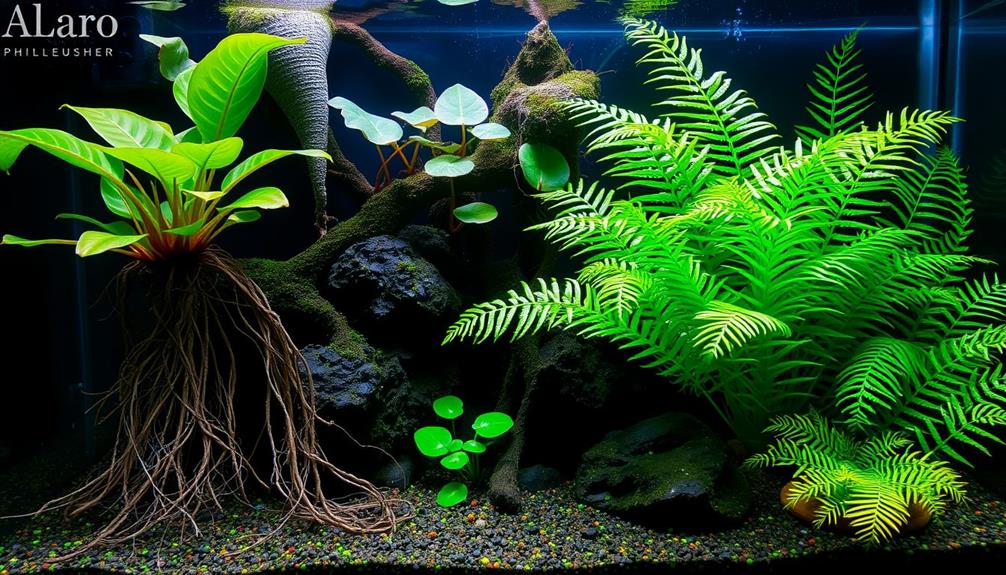
Choosing the right plants for your aquarium can make all the difference in creating a thriving underwater environment. Start by researching true aquatic plants that are compatible with your tank conditions, as this aligns with the benefits of fostering a healthy ecosystem for your fish and plants. This guarantees longevity and helps you avoid bog plants that may struggle.
Engaging in this selection process can also enhance your understanding of the educational value of play, as nurturing plants can be a hands-on learning experience for children.
Here are some essential plant selection tips:
- Opt for hardy species like Amazon Swords and Java Moss, which thrive in various water conditions.
- Investigate the specific lighting and nutrient needs of your chosen plants; this will greatly influence their growth and health.
- Consider the growth habits of the plants; stem plants grow quickly and need regular trimming, while rosette plants require a nutrient-rich substrate.
- Use beginner-friendly plant lists to simplify your selection process and set yourself up for success.
Frequently Asked Questions
How to Propagate Plants in an Aquarium?
To propagate plants in your aquarium, cut healthy stems below a node and replant them. For rhizome plants, divide and attach to rocks. Trim moss and fragments, then attach with thread for new growth.
How to Get Aquarium Plants to Root?
"Good things come to those who wait." To get your aquarium plants to root, take cuttings just below nodes, use nutrient-rich substrate, maintain stable water conditions, and provide adequate lighting for ideal growth.
Should I Remove Rock Wool From Aquarium Plants?
Yes, you should remove rock wool from aquarium plants. It can float, clog filters, and create debris. Gently dislodge the plant, wash off the wool, and trim any overgrown roots for better growth.
Should You Trim the Roots of Aquarium Plants?
Did you know that trimming roots can boost new growth by 30%? You should trim your aquarium plants' roots to encourage healthy development, but avoid excessive cutting to maintain their nutrient absorption and overall vigor.
Conclusion
Incorporating aquarium plants into your tank not only enhances its beauty but also improves the overall health of your aquatic environment. With the right trimming techniques and propagation methods, you can cultivate a vibrant underwater garden that thrives. So, why not immerse yourself in the rewarding world of aquarium plant care? By following the strategies outlined, you'll enjoy a lush and lively aquarium that you can be proud of. Happy planting!
